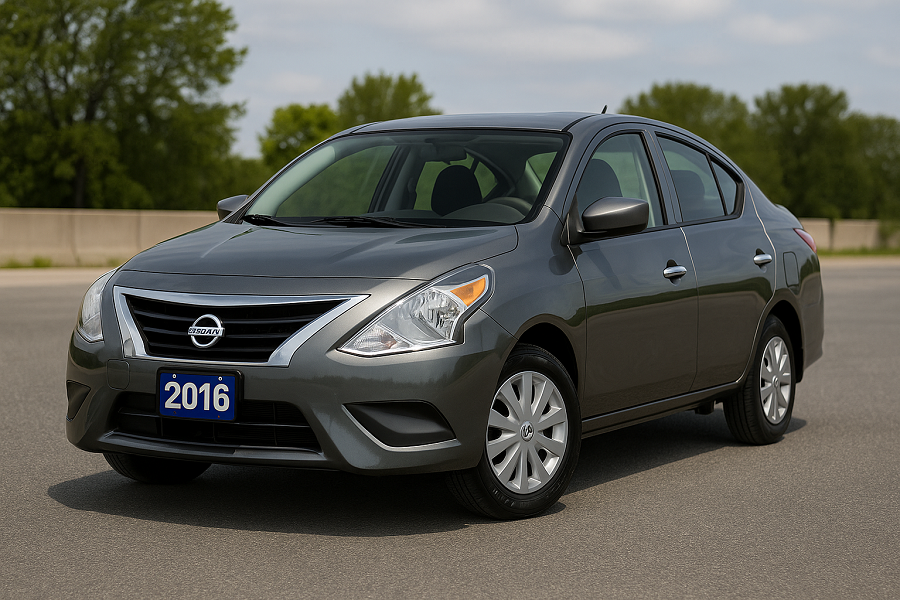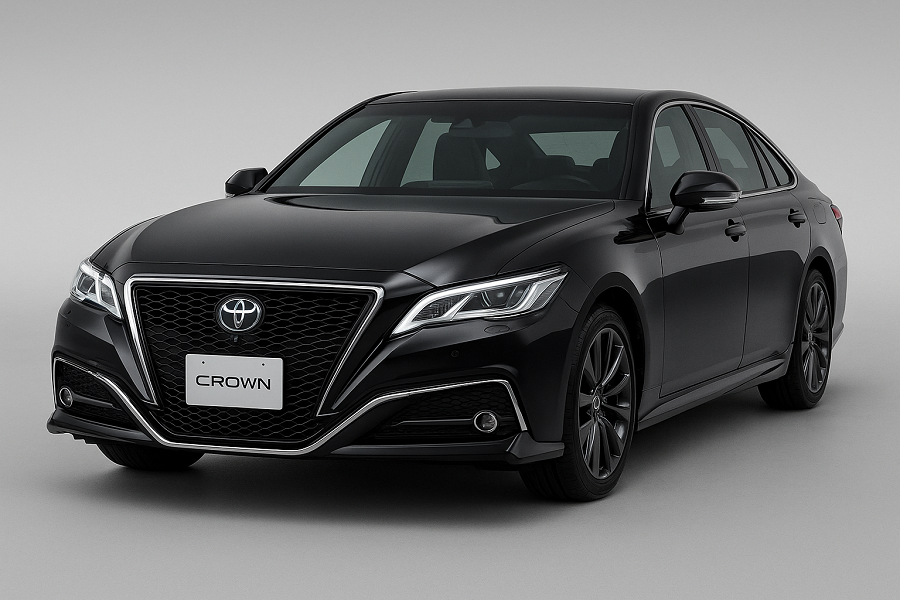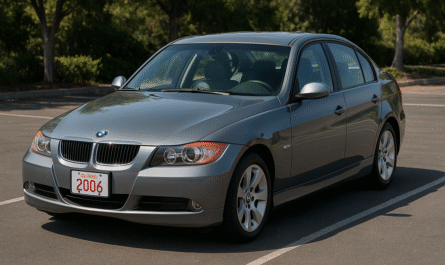Table of Contents
Table of Contents
The 2016 Nissan Versa stands out as one of the most inexpensive cars ever sold in the U.S., offering practical transportation for budget-conscious buyers. This subcompact sedan and hatchback (Versa Note) delivers impressive fuel efficiency, a spacious interior, and a low price tag. If you’re researching a used 2016 Nissan Versa in 2025, this complete guide covers everything you need to know, from specs to owner feedback.
Whether you’re a first-time buyer or looking for a reliable commuter, the 2016 Nissan Versa offers a compelling combination of value and functionality. Let’s dive into its key features, performance, and how it stacks up in today’s used car market.
Overview of Key Highlights
The 2016 Nissan Versa is all about delivering no-frills transportation without breaking the bank. It’s available as a sedan or a hatchback (Versa Note), with updates for 2016 like body-color power mirrors and a standard four-speaker sound system. Here’s what makes it stand out:
- Affordability: Starting at $12,815 when new, it was the cheapest car in America.
- Fuel Efficiency: Up to 35 MPG combined with the CVT.
- Spacious Interior: Roomy rear seats and a large trunk for its class.
- Reliability: Above-average reliability ratings from owners and experts.
This car targets practical buyers who prioritize cost savings over flashy features. It’s not a thrill ride, but it gets the job done.
Trim Levels and Features
The 2016 Nissan Versa comes in two body styles: sedan and Versa Note hatchback. The sedan offers four trims: S, S Plus, 2016 nissan versa sv, and SL, while the Note includes an additional SR trim for a sportier vibe. Each trim builds on the last, adding comfort and tech.
Comparison of 2016 Nissan Versa Sedan Trims
| Trim | Starting Price (2016) | Key Features |
|---|---|---|
| S | $12,815 | 5-speed manual, Bluetooth, 4-speaker audio, body-color mirrors, cloth seats, 15-inch steel wheels |
| S Plus | $14,865 | Adds CVT, cruise control, rear spoiler |
| SV | $16,315 | Power windows/locks, keyless entry, 60/40-split rear seats, upgraded upholstery, USB port |
| SL | $18,005 | NissanConnect, 5.8-inch touchscreen, navigation, rearview camera, push-button start, leather-wrapped steering wheel |
The 2016 nissan versa hatchback mirrors these trims, with the SR adding sporty touches like suede-like seats and a unique front fascia. The SL trim feels premium for a budget car, but even the base S offers decent valu
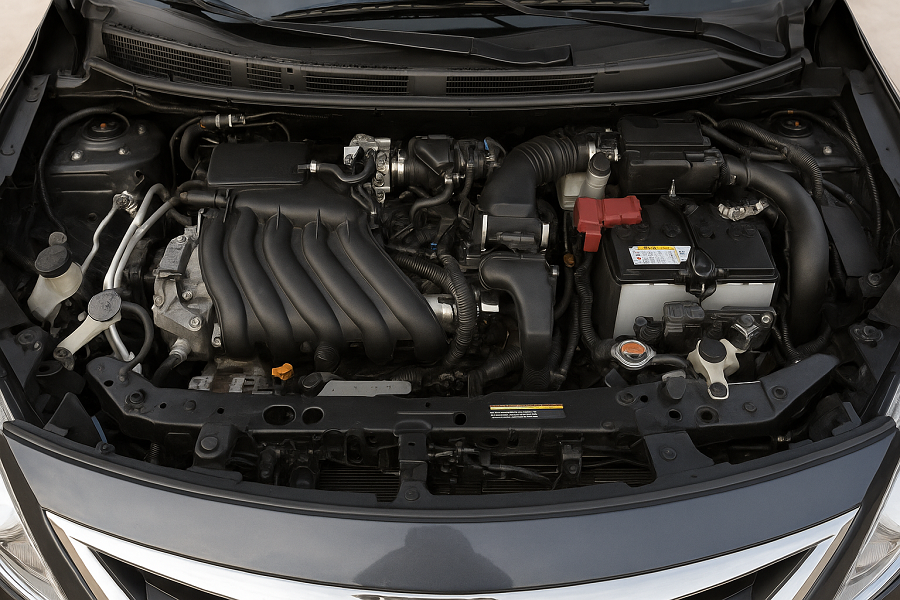
Engine, Performance, and MPG
The 2016 Nissan Versa is powered by a single engine across all trims. It’s not built for speed but shines in efficiency.
- Engine: 1.6L 4-cylinder, 109 horsepower, 107 lb-ft of torque
- Transmissions: 5-speed manual (S trim), 4-speed automatic (optional on S), or CVT (standard on higher trims)
- Performance: 0–60 mph in about 10.4 seconds (CVT), slower than most competitors
- Drivetrain: Front-wheel drive
Fuel Economy (EPA Estimates)
| Transmission | City MPG | Highway MPG | Combined MPG |
|---|---|---|---|
| 5-speed Manual | 27 | 36 | 30 |
| 4-speed Automatic | 26 | 35 | 30 |
| CVT | 31 | 40 | 35 |
The CVT is the clear winner for fuel savings, offering up to 40 MPG on the highway. This makes the 2016 Nissan Versa a top choice for commuters looking to save at the pump. Compared to rivals like the Toyota Yaris or Hyundai Accent, its CVT numbers are competitive, though manual versions lag slightly.
Interior Comfort and Space
The 2016 Nissan Versa interior prioritizes function over luxury. It’s surprisingly spacious for a subcompact, with a practical layout.
- Seating: Comfortable for four adults; rear seats fit three in a pinch.
- Cargo Space:
- Sedan: 14.7 cubic feet (S trim), 15 cubic feet (SV/SL).
- Versa Note: 18.8 cubic feet (rear seats up), 38.3 cubic feet (seats folded).
- Materials: Hard plastics dominate, but higher trims add soft-touch surfaces.
- Infotainment: Base models have a basic 4-speaker system; SL includes a 5.8-inch touchscreen with navigation.
The roomy rear seats and large trunk make it great for small families or road trips. However, the base trim’s crank windows and lack of power features feel dated.
Exterior Design and Colors
The 2016 Nissan Versa sedan sports a simple, inoffensive look with cues from larger Nissan models like the Sentra. The Versa Note hatchback has a sportier vibe with shorter overhangs and a “squash” line design. Updates for 2016 include:
- Standard body-color power mirrors across all trims.
- New colors: Cayenne Red and Gun Metallic.
- Other colors: Super Black, Fresh Powder, Brilliant Silver, and more.
The sedan’s design is functional but plain, while the Note’s hatchback style adds a touch of flair. Neither turns heads, but they’re practical for city driving.
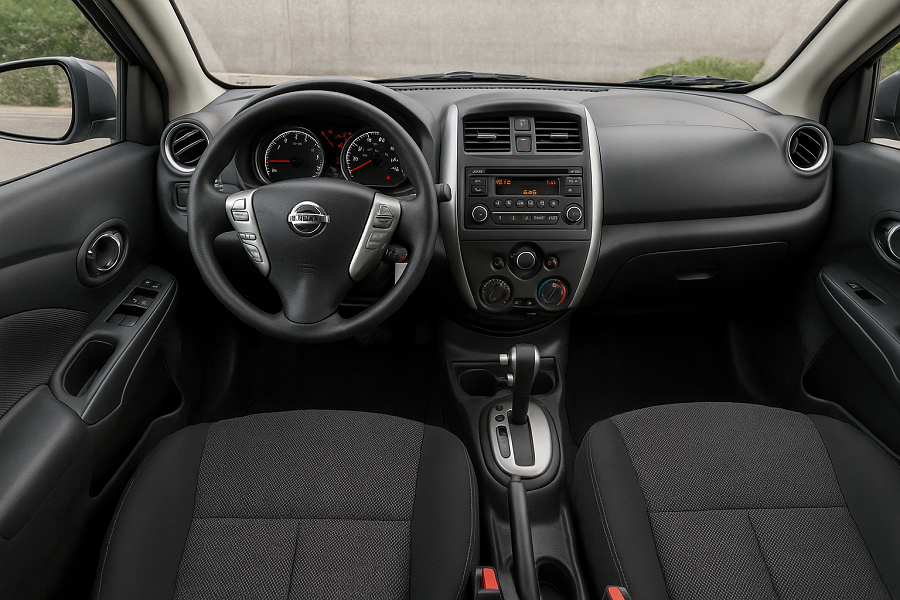
Safety Ratings and Features
Safety is a mixed bag for the 2016 Nissan Versa. It offers decent standard features but lacks some modern tech found in rivals.
- Safety Ratings:
- NHTSA: 4 stars overall (4 stars frontal, 5 stars side, 4 stars rollover).
- IIHS: “Good” in moderate front overlap and side crash tests; “Poor” in small-overlap crash test.
- Standard Safety:
- Advanced Air Bag System (dual-stage front, side, curtain).
- Anti-lock brakes (ABS), traction control, stability control.
- Optional Features (SV/SL): Rearview camera, tire pressure monitoring.
The lack of advanced driver aids like automatic emergency braking (standard in 2025 models) is a downside. Buyers prioritizing safety may prefer competitors like the 2016 Honda Fit.
Tech and Infotainment
The 2016 Nissan Versa’s tech is basic but functional, especially in higher trims.
- Base S Trim: 4-speaker audio, Bluetooth, trip computer.
- SV Trim: Adds USB port, power windows/locks, keyless entry.
- SL Trim: 5.8-inch touchscreen, NissanConnect with navigation, voice recognition, satellite radio.
- Versa Note SR/SL: Rearview camera, 5-inch display (SV), or 360-degree camera (SL).
The SL’s NissanConnect system feels modern for 2016, but base models lack Apple CarPlay or Android Auto. Tech-savvy buyers may find the Versa’s offerings limited compared to the Chevy Sonic or Kia Rio.
Driving Experience and Ride Quality
The 2016 Nissan Versa prioritizes comfort over sportiness. Its soft suspension absorbs bumps well, making it a smooth city cruiser. However, acceleration is sluggish, and handling feels lackluster.
- Ride Quality: Quiet and comfortable for a subcompact; handles road imperfections decently.
- Handling: Clumsy in corners; not built for spirited driving.
- Noise: Some road and engine noise at higher speeds.
For daily commutes or city driving, the Versa is easy to maneuver. Enthusiasts seeking fun should look at the Ford Fiesta or Honda Fit.
Maintenance Costs and Reliability
The 2016 nissan versa oil type is a budget-friendly car to own, with low maintenance costs and solid reliability.
- Reliability Ratings:
- J.D. Power: 3.5/5 (above average).
- RepairPal: 4/5 (13th out of 27 subcompact cars).
- Cars.com: 4.2/5 from owners.
- Maintenance Costs: Lower than average; expect $300–$500/year for routine upkeep.
- Warranty (2016): 3 years/36,000 miles (basic), 5 years/60,000 miles (powertrain).
Owners praise its durability, but some report issues with paint chipping and electrical glitches. Regular maintenance like oil changes (every 5,000–7,500 miles) keeps it running smoothly.
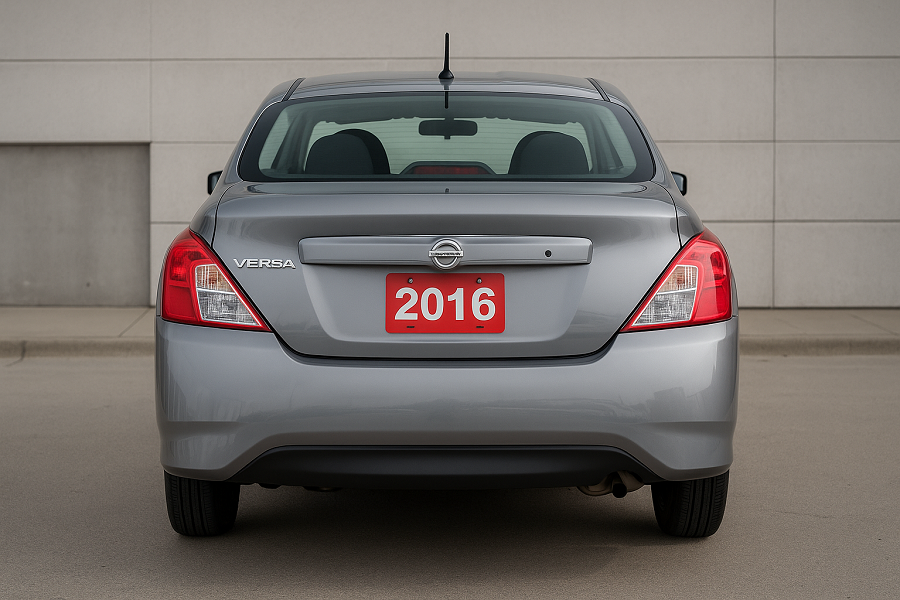
Pros and Cons
Pros
- Unbeatable starting price for a new car in 2016.
- Excellent fuel economy with CVT (up to 40 MPG highway).
- Spacious rear seats and trunk for a subcompact.
- Above-average reliability ratings.
- Easy to drive and park in urban settings.
Cons
- Sluggish acceleration, especially with CVT.
- Cheap interior materials in base trims.
- Limited advanced safety features.
- Noisy at highway speeds.
- Lacks driving excitement compared to rivals.
Common Issues Reported by Owners
While the 2016 Nissan Versa is generally reliable, some owners report recurring problems:
- Paint Chipping: Bubbling or peeling paint, especially on rear doors and trunk.
- Electrical Issues: Faulty window motors, stereo glitches, or airbag warning lights.
- A/C Compressor: Failures reported after warranty (costly repair, ~$1,000).
- Glove Box Design: Poorly designed, causing items to fall and prevent closing.
These issues aren’t widespread, but checking service history is wise when buying used.
2016 Nissan Versa vs. Competitors
The 2016 Nissan Versa faces stiff competition from other subcompacts. Here’s how it compares to the Toyota Yaris, Hyundai Accent, and Chevrolet Sonic.
Comparison Table: 2016 Nissan Versa vs. Competitors
| Feature | 2016 Nissan Versa | 2016 Toyota Yaris | 2016 Hyundai Accent | 2016 Chevrolet Sonic |
|---|---|---|---|---|
| Starting Price | $12,815 | $15,115 | $15,315 | $15,220 |
| Engine | 1.6L 4-cyl, 109 hp | 1.5L 4-cyl, 106 hp | 1.6L 4-cyl, 138 hp | 1.8L 4-cyl, 138 hp |
| MPG (Combined) | 35 (CVT) | 33 (Automatic) | 31 (Automatic) | 30 (Automatic) |
| Cargo Space | 14.7–15 cu. ft. | 15.3 cu. ft. | 13.7 cu. ft. | 14.9 cu. ft. |
| Rear Legroom | 37 inches | 33.3 inches | 33.5 inches | 34.6 inches |
| Safety (NHTSA) | 4 stars | 4 stars | 4 stars | 5 stars |
| Standard Features | Bluetooth, 4-speaker audio | Entune audio, USB | Power windows, USB | Apple CarPlay, Wi-Fi |
The Versa wins on price and rear legroom but falls short in performance and tech. The Sonic offers more power and modern features, while the Accent and Yaris provide better styling and acceleration.
Used Market Value in 2025
In 2025, the 2016 Nissan Versa remains a budget-friendly used car option. According to Kelley Blue Book, values have depreciated significantly:
- Resale Value: ~$3,737 (S sedan) to $6,574 (SL sedan).
- Trade-In Value: ~$1,172 (S sedan) to $3,500 (SL sedan).
- Average Used Price: $8,600–$13,600, depending on mileage, condition, and location.
Prices vary based on trim, mileage (expect 80,000–120,000 miles on a 2016 model), and regional demand. Low-mileage SL or Versa Note SR models command higher prices due to added features.
Is the 2016 Nissan Versa a Good Buy in 2025?
The 2016 Nissan Versa is a solid option for budget buyers in 2025, especially if you need a reliable, fuel-efficient car under $10,000. Its low maintenance costs and spacious interior make it suitable for daily use. However, its dated tech and lackluster performance may deter buyers seeking modern features or driving excitement.
Compared to a used 2018 Versa (starting at ~$12,100), the 2016 model offers more reasonable value with minimal feature trade-offs. If safety or tech is a priority, consider a used Honda Fit or Chevy Sonic instead.
User Reviews & Owner Opinions
Owners of the 2016 Nissan Versa share mixed but mostly positive feedback:
- Positive:
- “Great gas mileage! I drive 50 miles daily and fill up once a week.” – Cars.com review.
- “Spacious for a small car; fits my family of four comfortably.” – Edmunds user.
- “Bought it used for $9,000 in 2020; no major issues in 5 years.” – Consumer Reports.
- Negative:
- “Paint started peeling after 3 years; looks awful now.” – Cars.com review.
- “A/C died right after warranty; expensive fix.” – Kelley Blue Book user.
- “Feels underpowered on highways; passing is a struggle.” – Edmunds user.
Overall, 79.8% of Cars.com reviewers recommend the 2016 Versa, with an average rating of 4.2/5. It’s praised for reliability and cost but criticized for cheap materials and slow acceleration.
Conclusion: Final Thoughts
The 2016 nissan versa note remains a standout in the used car market for its unstoppable value, fuel efficiency, and big interior. While it lacks the polish or performance of rivals like the Hyundai Accent or Chevrolet Sonic, its low price and reliability make it a smart pick for budget-conscious buyers in 2025.
Whether you’re a student, commuter, or small family, the Versa delivers valuable transportation without breaking the bank. If you’re considering a used 2016 Nissan Versa, inspect for paint and electrical issues, and prioritize higher trims like SV or SL for better features. Test drive one today to see if this budget champ fits your needs!
FAQs
1. How reliable is the 2016 Nissan Versa?
The nissan versa 2016 has above-average reliability, with a 3.5/5 rating from J.D. Power and 4/5 from RepairPal. Owners report minimal issues, though paint chipping and A/C compressor failures are noted.
2. What is the fuel economy of the 2016 Nissan Versa?
With the CVT, it gets 31 MPG city, 40 MPG highway, and 35 MPG combined. The manual transmission yields 27/36/30 MPG, and the 4-speed automatic gets 26/35/30 MPG.
3. Is the 2016 Nissan Versa safe?
It earned a 4-star NHTSA rating and “Good” IIHS scores for moderate overlap and side crashes but a “Poor” score in the small-overlap test. Standard airbags and ABS are included, but advanced safety tech is limited.
4. How much is a used 2016 Nissan Versa worth in 2025?
Prices range from $8,600 to $13,600, with resale values of $3,737–$6,574 depending on trim and condition. Mileage and location also affect pricing.
5. How does the 2016 Nissan Versa compare to the Toyota Yaris?
The Versa is cheaper and has more rear legroom, but the Yaris offers better styling and slightly more responsive handling. The Versa’s CVT MPG (35) beats the Yaris’ 33 MPG combined.
